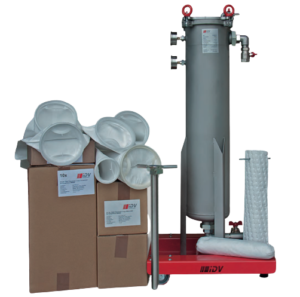
Why should we use micro particle filters in CNC and NC controlled machine tools?
Cutting oil emulsion (oil and water mixture), cutting oils or non-oily oils are used in all kinds of CNC or NC controlled machining benches today. Especially in the use of cutting oilemulsions, 2 main factors make the use of filters mandatory. One of these is the bacteria formed in the emulsion and the capillary or micro-chip residues of 1 to 20 µm in size, which are a natural result of machining that cannot be removed from the emulsion tank. Contamination of the emulsion with bacteria produces acute skin changes by operators, significant or quick change in pH value, a sign of severe microbiological invasion, conspicuous, unpleasant odor or odor that is significantly different from the new batch. On the other hand, sludge or slime formation or clogging coolant ducts of cutting tools due to capillary or micro-chipping generated by machining, clogging of shower area in machine tools and internal coolant pumps, phase separation (floating oil), destructive or harmful particle or Salt content (especially toxic alloy components from processed materials), Chloride ingress due to the use of chalky well water, or reduced conductivity due to machine corrosion are the main problems we face. All this results in less tool life and poor surface quality (especially in grinding and polishing applications) compared to a freshly filled machine.
As generally known, we live with bacteria. As beneficial bacteria make our life easier, harmful bacteria complicate our lives. Bacteria occur in the cutting oil emulsion tank due to the material processed over time, the body fluids of the operator working at the machine, and even the occational cigarette butt falling into the tank. In addition, the homogeneity of the oil is deteriorated by the mixing of different types of oils used in the machine tools into the cutting oil emulsion. Oils such as slideway or hydraulic oils cover the emulsion tank, especially during downtime, preventing the emulsion from breathing, so the bacteria existing in the system begin to multiply by anaerobic respiration. All microorganisms living in a cutting oil emulsion are fed on the components of the emulsion and secrete a large number of metabolic products. As a result, they change the properties of the emulsion in such a way that it becomes unusable. Temperatures between 26° and 38°C greatly increase bacterial growth. In addition, colonizing bacteria develop the basis for yeast production, and temperatures around 28°C are ideal for yeasts fungus. Sulfur (from free cutting steels) and other alloying components actually acts as fertilizer for some cultures. Fine, rough particles (especially below 25 µm) provide ideal environments for colonizing habitat. Floating oil (segregation) or improper flow (with zones of poor mixing, rough or rugged surfaces, blind corners in tank etc.) lead to the exclusion of air and lead microorganisms to anaerobic metabolism. This produces much more harmful degradation products (acids, ammonia, hydrogen sulfide, alcohols, etc.) than aerobic metabolism (predominantly CO2 and water). Anaerobic metabolic products are fertilizers for aerobic metabolic processes at other points in the system or for aerobic metabolic processes after mixing. Some bacteria form “biofilms”. These are slimy to gelatinous coatings that surround bacteria to protect them from leaching and chemical attack. These biofilms clog hoses, fittings and cooling channels. Especially in conjunction with fine chips, these biofilms can become very stable, often resulting in expensive and time-consuming repair and cleaning work.
Another factor that makes the use of filters essential is the chips of different sizes produced in the machining process. In machining, the chip sizes are relatively large, these chips are transported to the chip conveyor by means of cutting oil emulsion and removed from there to the chip trolley. However, in this process, a smaller part of the material is formed in the form of dust or mud. They may have a crystalline structure, be needle-shaped, spiral-shaped or in the form of curls (eg during finishing operations, grinding or polishing), or they may be more or less serrated, amorphous pieces (casting, steelworking).
These fine powders (< 25 µm) have a number of extremely irritating properties: The surface-to-volume ratio increases by a power of two (2) as the particle size of the chips decreases; in other words of a 2 µm particle has a 100 times greater surface area/volume ratio than a 20 µm particle.
They are also 100 times more chemically effective, which can have a fatal effect on the chemical stability of the emulsion, especially when it comes to copper alloys. This means 2that chip weighing 20 gr. with 2 µm particle size can have the same destructive effect as the chips weighing 2.000 gr. with 20 µm particle size. If the cutting oil emulsion needs to be disposed of early due to the increased toxic sludge content, this is always considered as toxic waste and/or disposal can result in huge costs. In addition, the toxic effect of these metals increases as the particle size decreases, because they can more easily enter the organism (for example, the skin) and develop a stronger effect there. Even copper can have a significant toxic effect as a microparticle penetrating the skin.
Many tool steels, but some aluminum alloys, also contain silicon or titanium as an alloying component. In molten steel, titanium becomes crystals of titanium carbide, silicon becomes silicon carbide (in steel) or silicon dioxide (in aluminum). The common feature of all these substances is that they form extremely hard, very small crystals or glass shards suspended in the emulsion due to their low specific gravity and cannot be caught by magnetic separators, band filters or drum filters. However, all of them have extremely high abrasive properties at maximum hardness, therefore increased concentration causes a rapid increase in tool wear and, depending on the machining process, also visibly degrades the workpiece surfaces. During casting processing, the surface of the material often contains significant residues of molding sand, which is released during processing. They also consist of extremely small very hard minerals (e.g. quartz) that are light enough to remain in permanent suspension and small enough to pass through band filter systems, magnetic separators, scrapers and centrifuges largely unaffected. Cast iron releases enormous amounts of cementite and carbon dust during processing, which, due to its enormous surface-to-volume ratio, remain suspended for a very long time, and because of its robust construction it is also an ideal growing substrate for a large number of bacteria and fungi. Particularly small particles (approximately 8 µm and smaller, depending on the specific gravity of the material) cause segregation in the emulsion, surrounding themselves with a layer of oil and colliding with other particles to eventually form larger floating oil droplets.
Band filter systems cannot solve the problem regardless of their design. Due to the low difference pressure of 50 mbar (max) on the filter mat – simply due to the capillary action of the emulsion – the band filter system must be rough enough to function as a pump protection grid in the best case. Particles smaller than 25 µm are not reliably captured by any belt filter system that, but they are at least partially responsible for almost all problems in emulsion and coolant system maintenance. It is also impossible to filter single-celled microorganisms (below 10 µm) in this way.
In addition to selection the appropriate coolant and additives, the most effective method is to reach the root of the problem quickly and completely by using filter cartridges with 1 µm mesh opening. With our 0.2 µm – 0.5 µm and 1 µm mesh filter cartridges, you can easily remove both the bacteria in the system and the microparticles that cause problems from your system. With the use of the filter cartridge, your cutting oil emulsion will continue to function by maintaining its current condition.
The filter unit operates in a closed circuit. Therefore, it does not rejuvenate as a system. The filter unit ensures that the oil is always fresh, clean and young. Your oil stays as clean, fresh and young as the first day. Thus, the usage conditions of the cutting oil emulsion remain constant.
With the advantages provided by the filter unit, the items listed below will no longer be a problem for you and you will be able to work with the same emulsion/cooling liquid for long periods without the need for machine tools cleaning.
With the use of the filter unit
1-) Bacteria and odor formation on the counter will be prevented
2-) Oil tank deformation will be prevented with the workbench and its components.
3-) Skin and shortness of breath problems that pose a danger to workers’ health will be prevented.
4-) The cost of boron oil spent for each oil tank filling will be eliminated.
5-) Smelting of used and expired coolant will be prevented
6-) Machine downtime will be prevented due to oil tank cleaning time
7-) Job loss will be prevented due to the personnel engaged to clean the oil tank
😎 As a result of not filtering the coolant well, residues on the machined part will be prevented due to particles of different sizes in the oil tank.
9-) In CNC machines with internal water supply system and high pressure pump, the pump malfunction disappears after the filter unit is used. Since the internal quenching device channels are clean, the sets with internal quenching channels do not clog and continue their work without any problems.
10-) The surface quality of the machined part will increase
11-) Oil or coolant will be used more effectively due to filtering. This will directly affect the tool life.
12-) The life of the cutting tool used on the bench will increase
13-) It will not be necessary to clean the tool holders and even the workbench, therefore, out-of-tolerance work caused by boron oil contamination in the holders will be prevented.
14-) The life of the moving parts or parts such as the bearings on the bench will increase and it will not require any maintenance other than periodic maintenance.
15-) The coolant/emulsion stays fresh with the use of filters.
16-) Aluminum shavings cause deposits in the bench tank. This is prevented by the filter unit.
You can check the link below for the video of the replacement of the membrane cartridge of the filter unit.
In order to be more descriptive, it would be more useful to share the information below. Although there are some exceptions, almost all CNC, machinin, grinding or plastic forming machines use cutting oil emulsion during manufacturing. The machine tool emulsion tank is contaminated by the metal chips of different sizes carried by the cutting oil emulsions and this pollution causes bacteria and yeast formation in the machine tool emulsion tank.
Bacteria and yeast formation cause the properties of the oil used to deteriorate, cause odor and occupational health and safety problems for emloyees and environment. The deterioration of the cutting oil emulsion conditions can cause shortening of the cutting tool life, loss of holder sensitivity, sometimes stains on the part machined and cause pump failures in machine tools which has high pressure pump of internal coolant supply and, decrease in the surface quality of the machined parts, shorten the economic lifetime of moving parts or components of the machine tool such as bearings and spindle.
Especially by grinding machines, an improvement of 30% and 50% in Ra values has been achieved and tool life of grinding wheels has been increased up to 3 times.
According to experience sieve opening of the filter systems used in the world is at least 25 µ. with exceptions. The particles that are mainly responsible for contamination of the cutting oil emulsion are particles with sizes of 1 to 20 µ. Band filters or central filtration systems are used at each machine tools. If the sieve opening is 25 µ, the cutting oil emulsion being used is also dirty and must be changed at regular intervals. With EM 5000 series filter system, neither the machine tool emulsion tank will be cleaned again nor the cutting oil emulsion in the tank will be changed. There are customers who have been using the same oil for 7 years.
In addition to all these advantages, it will have a positive effect on the calculation of carbon footprint values and reducing the carbon footprint values for reducing the effects of greenhouse gases formed as a result of activities such as production, service and processing determined according to the Kyoto Protocol prepared for a greener environment and the future.

